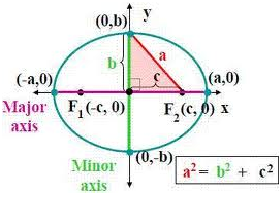Revision Notes on Ellipse
-
The standard equation of ellipse with reference to its principal axis along the coordinate axis is given by x2/a2 + y2/b2 = 1
-
In the standard equation, a > b and b2 = a2 (1 – e2) Hence, the relation between a and b is a2 – b2 = a2e2, where ‘e’ is the eccentricity and 0 < e < 1.

-
The foci of the ellipse are S(ae, 0) and S’ = (-ae, 0)
-
Equations of the directrices are given by x = a/e and x = -a/e
-
The coordinates of vertices are A’ = (-a, 0) and A = (a,0)
-
The lengths of the major and minor axis are 2a and 2b respectively.
-
The length of latus rectum is 2b2/a = 2a(1 - e2)
-
Distance between the two foci is 2ae and distance between directrix is 2a/e.
-
Two ellipses are said to be similar if they have the same eccentricity.
-
The sum of the focal distances of any pint on the ellipse is equal to the major axis. As a result, the distance of focus from the extremity of a minor axis is equal to semi major axis.
-
The circle described on the major axis of an ellipse as diameter is called the auxiliary circle.
-
If a question does not mention the relation between a and b then by convention a is assumed to be greater than b i.e. a > b.
-
The point P(x1, y1) lies outside, inside or on the ellipse according as x12/a2 + y12/b2 – 1 >, < or = 0.
-
In parametric form, the equations x = a cos θ and y = b sin θ together represent the ellipse.
-
Comparison Chart between Standard Ellipse:?
|
Basic Elements |
x2/a2 + y2/b2 = 1 |
|
|
|
a > b |
a < b |
|
centre |
(0, 0) |
(0, 0) |
|
vertex |
(±a, 0) |
(0, ±b) |
|
Length of major axis |
2a |
2b |
|
Length of minor axis |
2b |
2a |
|
foci |
(± ae, 0) |
(0, ± be) |
|
Equation of directirx |
x = ± a/e |
y = ± b/e |
|
Relation between a, b and c |
b2 = a2(1 – e2) |
a2 = b2(1 – e2) |
|
Equation of major axis |
y = 0 |
x = 0 |
|
Equation of minor axis |
x = 0 |
y = 0 |
|
Length of latus rectum |
2b2/a |
2a2/b |
|
Ends of latus rectum |
(± ae, ± b2/a) |
(± a2/b, ± be) |
|
Distance between foci |
2ae |
2be |
|
Distance between directrix |
2a/e |
2b/e |
|
Parametric equation |
(a cos θ, b sin θ) (0 < θ < 2π) |
(a cos θ, b sin θ) |
|
|
||
-
The line y = mx + c meets the ellipse x2/a2 + y2/b2 = 1 in either two real, coincident or imaginary points according to whether c2 is < = or > a2m2 + b2
-
The equation y = mx + c is a tangent to the ellipse if c2 = a2m2 + b2
-
The equation of the chord of ellipse that joins two points with eccentric angles α and β is given by
x/a cos (α + β)/2 + y/b sin (α + β)/2 = cos (α - β)/2 -
Equation of tangent to the ellipse:
-
The equation of tangent to the ellipse at the point (x1, y1) is given by xx1/a2 + yy1/b2 = 1
-
In parametric form, (x cos θ) /a + (y sin θ) /b = 1 is the tangent to the ellipse at the point (a cos θ, b sin θ).
-
Equation of normal:
-
Equation of normal at the point (x1,y1) is a2x/x1 – b2y/y1 = a2 - b2 = a2e2
-
Equation of normal at the point (a cos θ a, b sin θ) is ax sec θ – by cosec θ = (a2 - b2)
-
Equation of normal in terms of its slope ‘m’ is y = mx – [(a2 - b2)m /√a2 + b2m2]
-
The equation of director circle is x2 + y2 = a2 + b2
-
Chord of contact:
Pair of tangents drawn form outside point P(x1, y1) to the ellipse meet it at R and P. Line joining P and R is called the chord of contact of point P(x1, y1) with respect to the ellipse. The equation of chord of contact is
xx1/a2 + yy1/b2 = 1.

-
The portion of the tangent to an ellipse between the point of contact and the directrix subtends a right angle at the corresponding focus.
-
The perpendiculars from the center upon all chords which join the ends of any particular diameters of the ellipse are of constant length.
-
Chord with a given middle point:
AB is a chord of the circle whose mid-point is P(x1, y1). Then the equation of the chord AB is T = S1, where
S1 = x12/a2 + y12/b2 – 1 and T = xx1/a2 + yy1/b2 – 1.
-
Two diameters of ellipse are said to be conjugate diameters if each bisects the chords parallel to the other.
-
The eccentric angles at the ends of a pair of conjugate diameters of an ellipse differ by a right angle.
-
The sum of squares of any two conjugate semi-diameters of an ellipse is constant and equal to the sum of squares of semi-axis of ellipse.